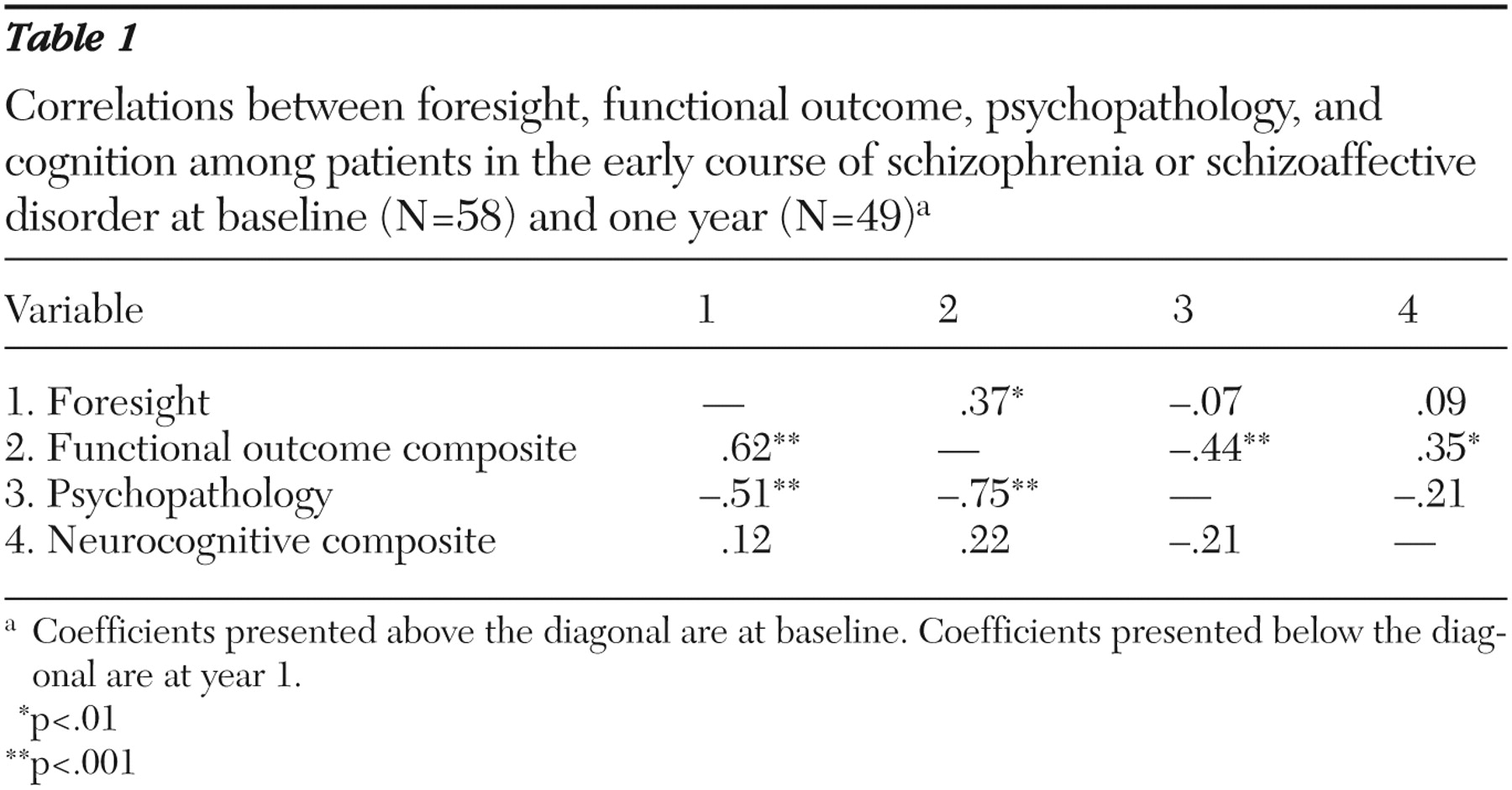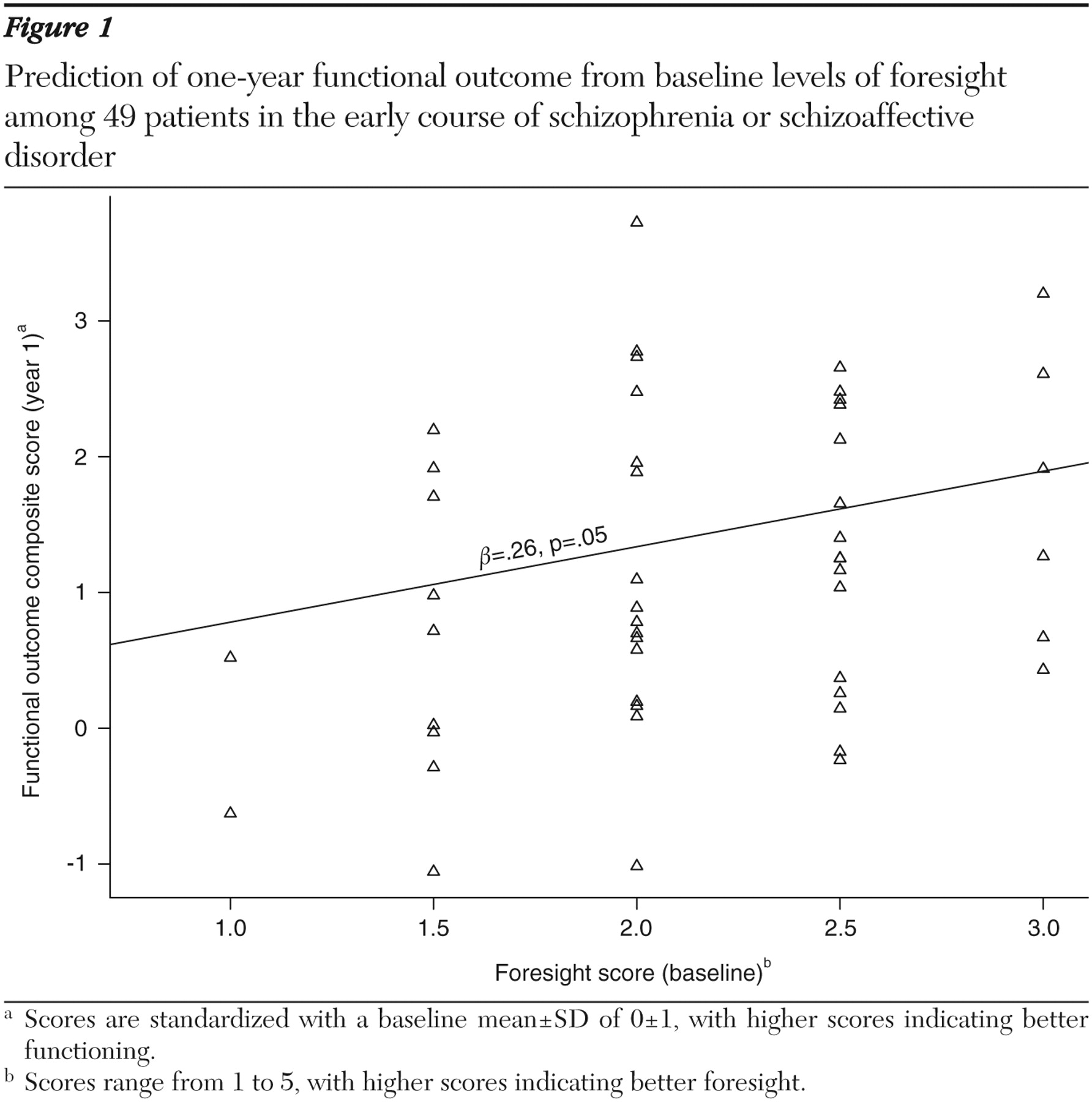Schizophrenia is a chronic and disabling mental disorder that is frequently characterized by severe social and functional disability (
1 ). Although a substantial proportion of individuals with schizophrenia do experience a functional recovery from the disease after years of illness (
2 ), many remain functionally disabled, particularly in the early phases of the disease (
3 ). Furthermore, recent evidence has indicated that despite the introduction of second-generation antipsychotic medications, functional outcome in schizophrenia has not substantially improved (
4 ), leading many to search for the "glass ceiling" of functional improvement in the disorder (
5 ). Research over the past several decades has highlighted the importance of psychopathology, particularly negative symptoms (
6 ), and neurocognitive dysfunction (
7 ) as two of the most robust and consistent predictors of functional outcome. Such factors have been shown to contribute to poor community adjustment, diminished quality of social relationships, and inhibited social skill and vocational capacity in both cross-sectional and long-term longitudinal studies of patients at various stages of the illness (
6,
7,
8 ).
Although studies have shown negative symptoms and neurocognitive dysfunction to be related to functional disability in schizophrenia, the actual contribution of these factors is not large, pointing to the importance of elucidating other key ingredients to functional outcome. For example, a meta-analytic review by Green and colleagues (
7 ) found that the average effect size of the relationship between neurocognitive ability and functional outcome in schizophrenia was r=.28 (range of r=.20–.40), and longitudinal studies have frequently revealed smaller effect sizes (
8 ). As Green and colleagues (
7 ) have noted, there are clearly other factors involved in producing the severe functional deficits associated with schizophrenia.
One factor that has been largely overlooked in schizophrenia research on functional disability—although it has been a centerpiece of effective psychosocial treatment development efforts for this population for over a decade (
9,
10 )—is the ability to think of the long-term consequences of one's behavior and use this information to guide present and future actions. This concept of foresight is an intuitively appealing dimension in the study of functional disability in schizophrenia, because a diminished capacity for recognizing the long-term consequences of one's behavior would seem likely to have a negative impact on interpersonal relationships in many different domains (for example, home and work), thus constituting a broad contributor to functional outcome.
Studies of other psychiatric populations have examined certain aspects of foresight, such as delay discounting (that is, the degree to which smaller rewards at shorter delays are preferred over larger rewards at longer delays [
11 ]), and found the concept to have significant utility in the prediction of clinical outcome (
12 ). In addition, a recent study of persons with schizophrenia examined delay discounting and found that such individuals were more likely than persons with no mental disorders in a control group to choose immediate, smaller rewards (
13 ), providing some evidence for the presence of a foresight deficit in this population. Consequently, the concept of foresight may hold promise as a key novel contributor to functional disability in schizophrenia. Unfortunately, studies have yet to examine the relationship between foresight capacity and functional outcome and determine whether this promising concept adds any predictive utility to functional disability beyond the leading predictors of functional outcome.
This research reports on the results of an opportunistic, exploratory longitudinal study of foresight among persons in the early course of schizophrenia and its unique predictive utility in regard to functional outcome. Data were used from an ongoing clinical trial of cognitive enhancement therapy.
Methods
Participants
Participants consisted of 58 individuals in the early course of schizophrenia (N=38, or 66%) or schizoaffective disorder (N=20, or 34%) participating in an ongoing randomized controlled trial of cognitive enhancement therapy (
14 ). Eligible participants included patients diagnosed within the past eight years, those with an IQ ≥80, and those who had not been abusing substances within two months of study enrollment. Participants were young, with a mean±SD age of 25.88±6.27 years. Sixty-nine percent (N=40) were Caucasian, 19% (N=11) were African American, 10% (N=6) were Asian, and 2% (N=1) reported their race as "other." Over two-thirds were male (N=40, or 69%). Most participants had received some college education (N=39, or 67%), but few were employed (N=15, or 26%). Participants had been ill a mean of 3.39±2.65 years. Psychiatric diagnosis was confirmed by the Structured Clinical Interview for DSM-IV-TR (
15 ).
In total 59 participants were recruited for this research; however, only 58 had complete baseline data, and only 49 were available for one-year data analysis because of patient attrition. All 58 participants with complete baseline data were included in this research; however, follow-up analyses were restricted to the 49 participants with complete follow-up data. No significant differences were observed between patients with complete one-year data and those lost to attrition with regard to demographic characteristics; however, those lost to attrition displayed significantly greater levels of psychopathology at baseline (F=4.92, df=1 and 56, p<.05).
Measures
Foresight was measured by using two global assessment items included as part of two larger assessment batteries developed to assess social cognition in schizophrenia (
16 ). These included the items "Inability to assess long-term consequences (good and bad) of behavior; difficulty forming long range plans" and "Could see the future outcome of behavior; took a long view." Items were rated during the course of a clinical interview by clinicians who were intimately involved in the patient's treatment and had been trained to administer these measures by their original authors. Both foresight items were rated on a 5-point scale, with lower scores indicating poorer foresight. The items were based on anchors of behavioral frequency and were averaged to compute a single foresight rating. We previously documented adequate levels of interrater agreement (all intraclass correlations <.77, with no significant differences between raters) on the larger social-cognitive assessment batteries from which these foresight measures are derived (
16 ). In addition, foresight items were moderately intercorrelated at baseline and year 1 (mean interitem r=.46), suggesting that they both provided some shared and unique information with regard to foresight. Finally, the computed average measure of foresight was generally unrelated to psychopathology (r=-.07) (
Table 1 ), cognitive ability (r=.09) (
Table 1 ), and illness duration (r=-.12) at baseline, suggesting that our measure of foresight possessed some level of divergent validity from likely potential confounds.
Functional outcome was assessed by using the Social Adjustment Scale-II (
17 ), a widely used measure of social adjustment; the Performance Potential Inventory (
16 ), a 55-item clinician-rated measure of functional disability based on the Social Security Administration's employability criteria (
18 ); and the Global Assessment Scale (
19 ). Items from these measures were scaled and combined to form a composite index of functional outcome, which displayed excellent internal consistency (
α =.93). Higher composite scores indicate better functioning. Neurocognition was assessed by using a composite index employed in our previous work (
16,
20 ) consisting of selected measures from the third version of the Wechsler Memory Scale (
21 ), California Verbal Learning Test (
22 ), Wisconsin Card Sorting Test (
23 ), Trails B (
24 ), and the revised Wechsler Adult Intelligence Scale (
25 ). Higher composite scores indicate better neurocognitive ability. We found the reliability of this composite to be adequate (
α =.88). Finally, psychopathology was assessed by using the Brief Psychiatric Rating Scale (
26 ), which was found to display adequate internal consistency (
α =.77).
Procedures
Participants were recruited from Western Psychiatric Institute and Clinic in Pittsburgh and several nearby community clinics. Upon recruitment, participants were randomly assigned to a trial of cognitive enhancement therapy or an active control condition, which has been described in detail elsewhere (
14,
27 ), and assessed yearly using a battery containing the aforementioned measures of foresight, functional outcome, neurocognition, and psychopathology. The larger study was approved and reviewed annually by the University of Pittsburgh Institutional Review Board. All participants gave written informed consent before participation.
Data analysis
Descriptive and bivariate correlation analyses were used to characterize the level of foresight among participants and to examine the bivariate relationship between foresight, psychopathology, neurocognitive ability, and functional outcome. Hierarchical linear regression analyses were used to examine the unique contribution of foresight to functional outcome, after first adjusting for psychopathology and neurocognitive ability. In addition, because this research was conducted within the context of a randomized controlled trial, regression analyses of follow-up data adjusted for treatment assignment to account for the potential confounding effects of treatment on the constructs of interest.
Results
Inspection of foresight means indicated that on average patients had moderate to severe foresight impairment at both baseline (mean score of 2.17±.51) and the one-year follow-up (mean score of 2.86±.70). (Possible scores range from 1 to 5, with higher scores indicating better foresight.) Bivariate correlation analyses presented in
Table 1 indicated that greater foresight at both baseline and year 1 was significantly associated with better functional outcome, whereas no significant relationship was observed at any time point between foresight and neurocognition. Interestingly, although foresight was not related to psychopathology at baseline, a significant negative relationship was found at year 1. As expected, lower levels of psychopathology and greater neurocognitive ability were related to better functional outcome throughout the course of the study, although the relationship between neurocognitive ability and functional outcome at year 1 was attenuated and not statistically significant.
Results from a series of hierarchical linear regression analyses examining the incremental predictive utility of foresight in regard to functional outcome indicated that foresight continued to explain a significant proportion of the variance in functional outcome beyond psychopathology, neurocognition, and treatment assignment at both baseline (
Δ R
2 =.10,
Δ F=8.78, df=1 and 54, p=.01) and year 1 (
Δ R
2 =.06,
Δ F=7.09, df=1 and 44, p=.01). As can be seen in
Figure 1, greater foresight at baseline also continued to significantly predict better functional outcome one year later, even after the analyses adjusted for psychopathology, neurocognitive ability, and treatment assignment (
Δ R
2 =.07,
Δ F=4.19, df=1 and 44, p=.05).
Discussion
Elucidation of the factors that conspire against functional recovery from schizophrenia has become an important focus of schizophrenia research. Studies have pointed to psychopathology and cognitive dysfunction as two of the most robust contributors to functional disability in the disease (
6,
7,
8 ); yet the magnitude of these relationships has indicated the importance of identifying other factors contributing to functional outcome. This study took the first step in exploring the unique predictive utility of foresight—a novel concept in schizophrenia research referring to one's ability to think of the long-term consequences of one's behavior and use this information to guide present and future actions—in regard to functional outcome. Results indicated that persons with schizophrenia were impaired on global measures of foresightfulness and that foresight was significantly predictive of future functional outcome, above and beyond the effects of psychopathology and neurocognitive ability. Such findings preliminarily point to the potential utility of this novel concept for understanding the barriers to a more complete functional recovery from schizophrenia and lend some support to previous psychosocial treatments that have in part targeted impairments in foresight (
9,
10 ).
Although these exploratory findings may point to a promising new area of investigation in schizophrenia research, this study is admittedly limited by its global measurement of foresight—a construct that contains a number of different domains, such as temporal myopia and delay of gratification, not all of which may be significant to persons with schizophrenia. In addition, although our measures of foresight demonstrate high degrees of face validity and adequate interrater reliability on the broader measures from which they were derived, as well as some level of internal consistency and divergence from likely potential confounds, more rigorous psychometric investigation of these measures is needed before firm conclusions can be drawn from this research. Future studies will need to focus on the development and psychometric evaluation of expanded measures of foresightfulness that more broadly cover the domains of the concept and will need to investigate the relevance of these domains to persons with schizophrenia. The development of performance-based measures designed to more directly assess a person's foresight ability could be particularly useful, because neither interview-based nor behavioral measures can distinguish between the ability to be foresightful and the propensity to use this ability.
In addition to limitations in measurement, this research was also limited by an absence of a control group, which precludes conclusions regarding the magnitude of impairment in foresight among persons with schizophrenia. This research was conducted with a group of young patients in the early course of the disease, and their impairment in foresight may either reflect a developmental arrest stemming from the onset of the illness or may merely mirror the level of foresight encountered by most young individuals, regardless of disability.
Some investigations of healthy individuals have conceptualized foresight as a cognitive skill that has been shown to develop with age (
28 ), which might suggest that the foresight impairments seen in this research reflect a normal process of skill development. On the other hand, the magnitude of foresight impairment observed in this sample seems to indicate the possibility of a real deficit, even compared with healthy individuals of the same age, because the sample as a whole was rated as having poor foresight, particularly at baseline. Unfortunately, in the absence of an age-matched group of participants without schizophrenia, the degree to which schizophrenia is characterized by a foresight deficit remains unclear. Consequently, it will be important for future research to investigate both the degree and specificity of foresight impairments in this population by making use of control groups of healthy individuals and persons with other psychiatric disorders. A clear understanding of the magnitude of foresight impairments in schizophrenia could provide an impetus for the further development and dissemination of rehabilitation programs designed to improve foresight among this population.
Finally, this research is limited by its modest sample size, which may have precluded the detection of significant effects between foresight and neurocognitive ability. Studies employing larger samples could provide further information regarding the cognitive correlates of foresight.
Conclusions
This first examination of the functional significance of foresight in schizophrenia indicates that persons with the disease may possess some impairment in foresightfulness and that such impairments are significant predictors of future functional outcome, even after psychopathology and neurocognitive ability are adjusted for. These findings point to foresight as a promising new domain for research on functional disability in schizophrenia that could bring us closer to understanding the factors that conspire against broader functional recovery from the disorder.
Acknowledgments and disclosures
This work was supported by grants MH-60902 (MSK) and MH-79537 (SME) from the National Institute of Mental Health. The authors thank the late Gerard E. Hogarty, M.S.W., for his leadership and direction as co-principal investigator of this work and Deborah Greenwald, Ph.D., Susan Hogarty, M.S.N., Susan Cooley, M.N.Ed., Anne Louise DiBarry, M.S.N., Konasale Prasad, M.D., Haranath Parepally, M.D., Debra Montrose, Ph.D., Diana Dworakowski, M.S., Mary Carter, Ph.D., Sara Fleet, M.S., and George Manish for their help in various aspects of the study.
The authors report no competing interests.



